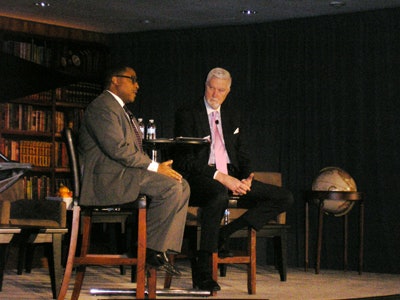NEW YORK — From crisis management to fan engagement, the annual Intercollegiate Athletics Forum allowed leaders in the collegiate landscape to touch base and exchange ideas.
Crisis management
In the not too distant past, the timeframe for publicly addressing pressing issues and crises in college sports or other institutional emergencies was 24 to 72 hours. Now it is two to three minutes. Panelists on the Crisis Management: Proactive Steps for Mitigating Risk and Being Prepared When a Crisis Strikes panel said they could not emphasize enough the importance of being proactive.
 Attorney Tyrone Thomas, left, discusses possible legal issues related to student-athlete activism with Tom McMillen.
Attorney Tyrone Thomas, left, discusses possible legal issues related to student-athlete activism with Tom McMillen.Jim Livengood, former athletic director of the University of Arizona, UNLV and Washington State University, said social media will jump on the information almost instantly—in many cases before administration even knows about it—so a complete crisis plan must be in place.
While instincts may prompt administration to try to keep things under wraps until some resolution can be found, that isn’t a viable option in the present day. Carrie Gerlach Cecil, CEO of Social Media Sports Management, said tell the truth and tell it quickly. If the crisis leads to litigation, a digital footprint showing the institution did the right thing is crucial.
Obviously, different situations require different reactions—whether it’s an incident of sexual misconduct or a cheating scandal—and an institution must react accordingly. In advance, think through many possible scenarios and establish who will be making public statements.
Former athletic director Dan Beebe, now a private consultant, said it’s important to have an independent outside entity set up the crisis procedures so that every possible angle is examined. Beebe also advised to reflect diversity in the decision making process and also in the group examining any crisis issue.
The panel’s moderator, Glenn Wong, executive director, sports law and business program at the Sandra Day O’Connor College of Law at Arizona State University, said, “Lawyers light up when there is no policy and procedure.”
Legal issues
While not necessarily a crisis, student-athlete activism has caused legal issues to arise in college sports. In the one-on-one discussion, Legal Issues Facing College Athletics, Tom McMillen, president and CEO of LEAD1 and a former U.S. congressman, asked Washington, D.C., attorney Tyrone Thomas how institutions should address student-athlete rights and school rights.
Thomas referenced football team protests at both the University of Missouri and Grambling State University. He said it’s important to know what the underlying issues and cause of the protests are.
“With any expression of speech or any expression of conduct the issue is what are you trying to convey?” said Thomas, who frequently addresses sports-related issues in his practice. “The difference, and legal cases back this up, is if you have an expression that deals with something that’s a public concern versus if you’re dealing with some type of activity that quite frankly is more an expression of improving your own circumstances.”
Divisive issues can impact staff as well as student-athletes, and an institution may restrict certain activity on social media. Institutions cannot ban expression, but there are ways expression can be funneled into viable venues.
“I would encourage many of us to have a more active role with those outside constituents and interest groups that have interest in our student-athletes,” said Thomas. In professional athletics there have been instances where there is not a great articulation about why the athletes are involved in certain expressions.
McMillen said athletes have protested since time immemorial. He was personally involved in the 1972 U.S. men’s Olympic basketball team boycotting the medal ceremony because they felt they had been the victims of a biased and incorrect official’s decision that led to their defeat. In the years since, the team has continued to refuse the International Olympic Committee’s offer of the silver medals.
Thomas said there is the persistent issue of the demographic difference between the student-athletes on the field of play and the people who run athletic programs. There is a need for some difficult conversations about the concerns of student-athletes before they engage in activism that may cross a line and lead to consequences.
They concluded the session by discussing the incoming presidential administration and how that will impact student protest. Thomas said we have to see how the new administration affects the Department of Education’s oversight of college sports, especially Title IX.
“We have to see how far that pendulum swings,” said Thomas, referencing content expression. Student-athletes may face stop-and-frisk issues or there may be clashes of opinion with donors or board members.
“Where will this pendulum go on race issues?” McMillen asked. “I do think President-elect Trump will be a very important figure in college sports because I do think in the next four years a lot of the existential issues that we face in college sports will come to a head.”
Thomas advocated for frank discussions and training for coaches and athletics staff in handling possible issues that may arise.
“This is now part of the new world order of athletics,” said Thomas.





















